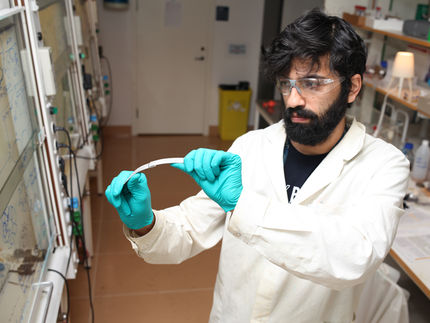Super liquid-repellent dry adhesives
Scientists outsmart nature
A specific fibril tip shape design is the key to achieving elastic dry fibril adhesives with super liquid repellency. This new bioinspired material opens up many possibilities for use, as it prevents any form of liquid droplet or layer from hindering or degrading its adhesion.
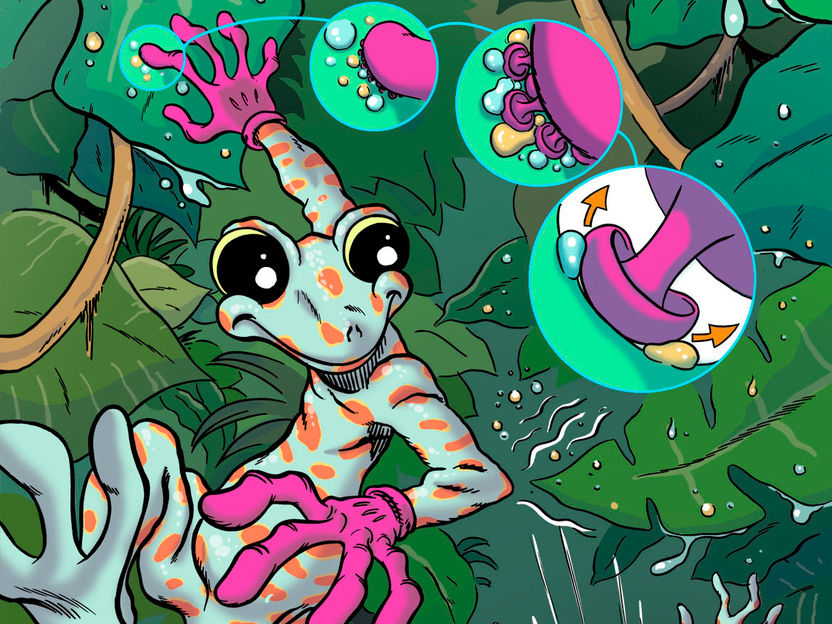
MPI für Intelligente Systeme
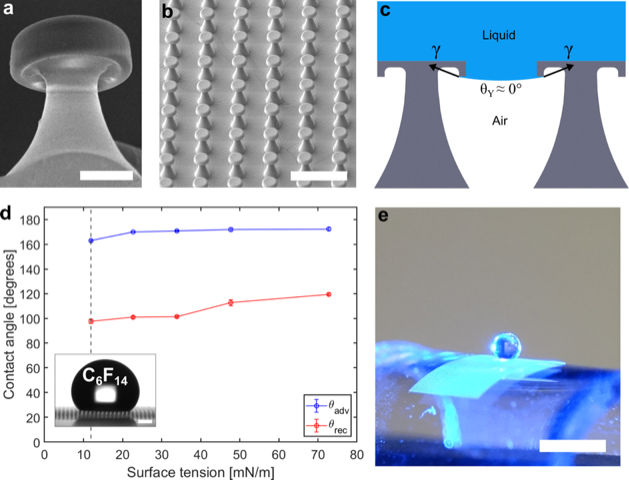
Figure 1. Bioinspired liquid super-repellent dry adhesives. a) SEM micrograph of a single soft fibril showing the double re-entrant tip that enables extreme liquid repellency. b) SEM micrograph of a soft fibril array, which functions as a highly effective dry adhesive. c) The principle of liquid super-repellency using double re-entrant fibril tips: surface tension (Y) has a vertical component that supports liquids on the fibril array. d) Advancing (blue) and receding (red) contact angles of various liquids on the fibril array, showing that even liquids with extremely low surface tension, such as perfluorohexane (C6F14, Y = 11.91 mN/m), can be suspended on the array. e) A droplet of methanol (Y = 22.70 mN/m) suspended on curved fibril array, which is bendable and stretchable due to the softness.
MPI für Intelligente Systeme

Figure 2: Fabrication of soft elastomeric mushroom-like double re-entrant fibril arrays. Schematic of the fabrication process. A rigid master mold is 3D-printed using two-photon lithography, and then replicated using soft PDMS (20:1 monomer to crosslinker ratio) for the negative replica and standard PDMS (10:1 monomer to crosslinker ratio) for the final replica.
MPI für Intelligente Systeme
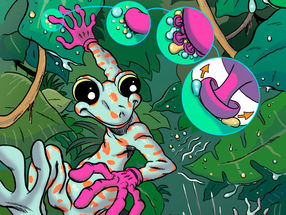
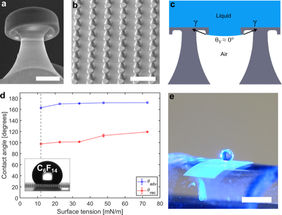
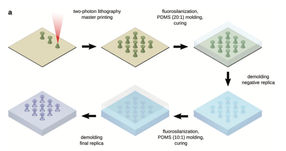
Stuttgart – Scientists at the Max Planck Institute for Intelligent Systems (MPI-IS) in Stuttgart have developed a bioinspired reversible dry adhesive material that is able to repel all liquids, regardless of their surface tension. While dry adhesives have been actively studied and applied for two decades, a super liquid-repellent dry adhesive has never been achieved before.
“Our material effectively repels not only water, but any liquid. Oils, for example, which easily wet surfaces due to their low surface tension, would normally spread on and between the fibrils – the fine hairs – causing them to clump together and lose adhesion. But because of the specific tip structure we have created, our fibrils can fend off all liquids, including oils,” Ville Liimatainen explains, highlighting the key feature of the adhesive. Liimatainen is a postdoctoral researcher in the Physical Intelligence Department at the MPI-IS and lead author of the publication “Liquid‐Superrepellent Bioinspired Fibrillar Adhesives”, which was recently published in Advanced Materials. The senior author is Metin Sitti, a Director at MPI-IS and head of the Physical Intelligence Department. Sitti is a pioneer in the research field of gecko-inspired dry adhesives. He is also the founder of nanoGriptech Inc., a start-up that commercialized several nature-inspired dry adhesives.
Most of the Physical Intelligence department’s research is inspired by nature and the blueprints it provides, and this project was no exception. Ville Liimatainen, Dirk Drotlef, Donghoon Son, and Metin Sitti took inspiration from the tiny fibrils on a gecko’s footpads. Each one is covered with hundreds of thousands of tiny mushroom-shaped knobs, which allow the animal to effortlessly climb up practically any surface. Synthetic mimics of these fibrillar adhesive systems have been studied for decades, with performance reaching and sometimes even surpassing that of geckos. Dry adhesives do not require any chemicals or glue to make them stick to almost any surface. Moreover, they are reusable, soft, bendable, and stretchable. However, they fail when they get wet, as do gecko footpads: faced with wet conditions, the gecko’s ability to adhere to slippery surfaces decreases dramatically.
Scientists outsmart nature
By changing the shape of the fibril tips, the scientists were able to outsmart nature and make their dry adhesive super-repellent to water and other liquids. “To give you examples: Gecko-inspired dry adhesives would now be able to stick to any wet surface without any adhesion loss, and a climbing robot using bioinspired dry adhesives would be able to climb on surfaces with any liquids. Alternately, a robot hand equipped with a layer of such an adhesive would be able to pick-and-place any object covered in liquid,” Sitti adds.
As seen in figure 1c, the arrows represent the vectors of the surface tension. Even if a liquid can spread to the bottom corners of the fibril tips, surface tension will have an upward- pointing component, as indicated by the arrows. This force supports the liquid, which then cannot slip down between the fibrils. “This is all thanks to the overhanging T-shape geometry of the fibril tip, which can stop even ultralow-surface-tension liquids,” Liimatainen explains.
Each fibril is 40 micrometers in height and 10 micrometers thick at the narrowest point just underneath the cap, which has a diameter of 28 micrometers. This size ratio combined with the special fibril tip shape and the use of stretchable, scratch-resistant soft silicone elastomer as the building material enables durable dry adhesives with strong adhesion and extreme liquid repellency.
